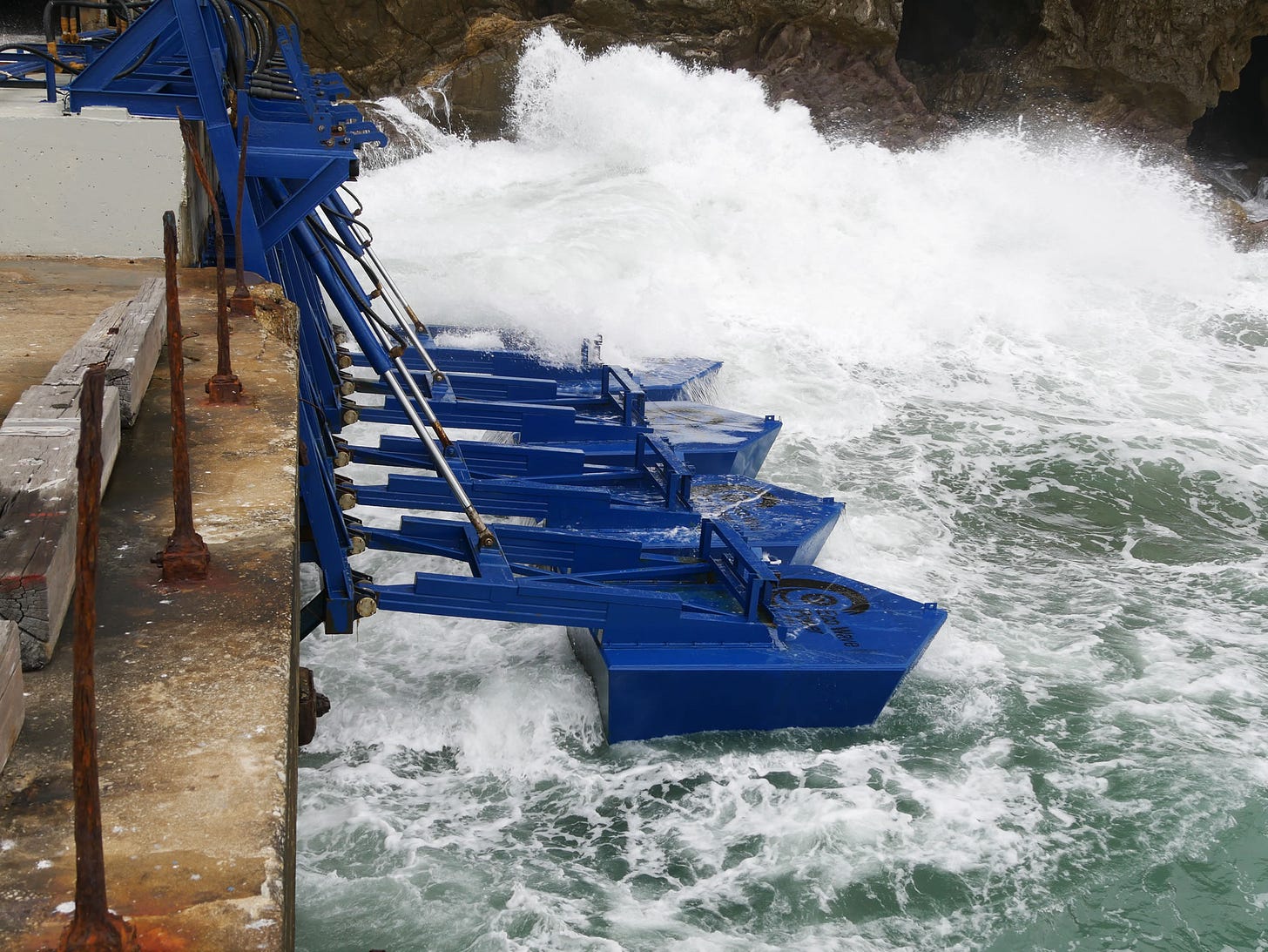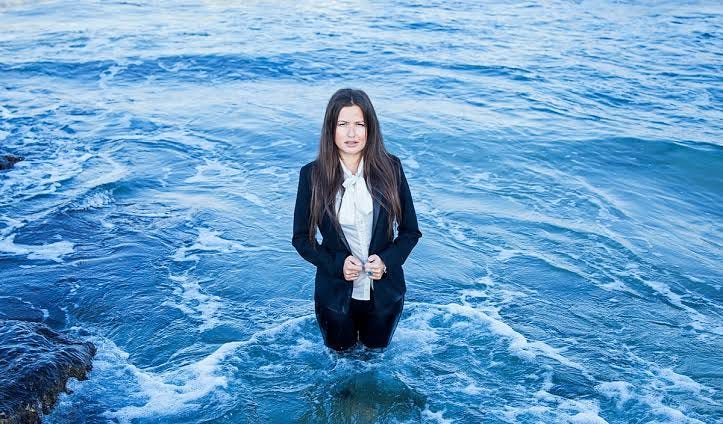Hot Stuff, Etc. : Climate, Energy & Jalapeño News
Tapping the oceans, steel made without coal & why I love hot peppers.
In case you’ve developed ennui continually reading about Albert Camus, the Impressionists, the Bonapartes, and other dead Frenchmen, or you’re wondering if this newsletter is now going to consist only of strange tales involving every colorful person I’ve ever met — including “The Most Dashing Yachtsman in Capri” — fret not.
We do sometimes take on serious, important, and relevant topics around here.
This week we’re looking at possible solutions to daunting issues like climate change and energy, as part of a new monthly column from Rossi Reports called “Hot Stuff, Etc.,” that will explore everything from global warming to jalapeños, new technologies to sex.
As for “The Most Dashing Yachtsman in Capri,” he will make an appearance next week.
Power from the Sea
When it comes to finding new ways to produce electricity that don’t emit greenhouse gases, the most significant arena is marine energy — tapping the power in tides, waves, and differences in water temperatures, a topic I recently explored for Outrider.
The potential for marine energy to meet the world’s electricity needs is vast. According to the International Renewable Energy Agency (IRENA) “ocean energy could cover more than twice the current global demand for electricity.”
For well over a century, humans have been trying to unlock that energy of the seas — for example, by floating serpentine devices atop waters to tap the kinetic energy in waves, anchoring windmills to ocean floors to capture the energy in tides, and building offshore platforms with giant tubes that sucked up seawater to make electricity from difference in temperatures in surface and bottom waters.
The field has experienced spectacular failures, as violent storms and huge waves smashed devices to smithereens. However, impressive gains are finally being made: hefty funding from the European Union and the US Dept of Energy is spurring a slew of new devices, many of them now being tested in Scotland and off the coasts of Oregon, California, and Hawaii.
The US Dept. of Energy has estimated that wave energy alone could supply 34% of the US electricity demand. All forms of ocean energy together, according to that same DOE report, could potentially supply nearly two-thirds of US electricity demand.
For me, the most promising marine energy innovation is also the simplest.
Eco Wave Power, a Swedish-Israeli wave energy company relies on existing infrastructure such as piers and jetties — over which they hang metal floats that resemble rowboats. As these floats bob up and down on the waves, those actions move pistons and ultimately produce carbon-free electricity from waves.

The beauty of this no-frills design, which generates its electricity onshore, is that it doesn’t require weather-vulnerable offshore equipment or underwater cables and it sidesteps the huge costs of construction and maintenance.
“The costs in offshore [marine energy] production — like the operation, construction, maintenance — become sky high because you need ships and divers and underwater moorings and cables,” Eco Wave Power CEO Inna Braverman told me. “We’re enjoying the advantages of being connected to an existing [near-shore] structure in terms of access, price, and reliability.”
Eco Wave Power already has one small plant connected to the grid from the port of Jaffa in Tel Aviv, where it provides electricity to around 100 homes. The company is also conducting a high-profile pilot demonstration in California — the first onshore wave energy project in the US — along a pier at the port of Los Angeles, which is part of AltaSea, a marine laboratory of sorts that tests out different devices.
In Portugal, Eco Wave Power is also launching another 20-megawatt power station in four locations, which they bill as the “first commercial-scale wave energy project in the world.” That wave-generated electricity is anticipatedto power around 13,000 homes. Other demonstrations are planned in Spain and Thailand.
Shell Oil appears to be very interested in Eco Wave Power — signing a strategic co-investment agreement with Eco Wave Power to help underwrite the project at the AltaSea pier in Los Angeles and, earlier this year, funding a study that showed this simple technology could be employed at 77 sites in the US alone.
Green Steel Soon to Make World Debut
Since the mid-1800s, steel has been married to coal — the fuel which most easily allowed temperatures of up to 3000 degrees F. to make the durable metal from iron oxides. As a result, steel production has long produced huge emissions of greenhouse gases: the steel-making process alone is responsible for at least 7% of the global release of carbon dioxide — and 10% or more if you factor in mining and other parts of the process.

That’s why eyes are turning to Boden in northern Sweden, where Swedish startup H2 Green Steel is launching the world’s first large-scale “green steel” plant.
Instead of coal, the plant is fueled by “green hydrogen” derived from electrolysis of water using wind energy and solar power. According to H2 Green Steel, the plant, which is envisioned to start production next year, will reduce carbon dioxide emissions by 95% compared to traditional steel-making methods — and will be cranking out 30 million metric tonnes of steel by 2030.
Why this is important: green hydrogen is believed to be the only non-carbon-producing fuel that can power “hard-to-abate” sectors like steel production, glass making, shipping, and long-distance trucking — all of which have relied on CO2-producing fossil fuels.
Hydrogen could also be used to generate electricity, to heat homes, and to power bus fleets, trains, and even bicycles — although the analysts I’ve talked with discourage those uses, which could instead be directly powered by electricity; they see using hydrogen for these forms of transportation as a wasteful and unnecessary added step simply because it takes so much electricity to produce green hydrogen.
To make “green hydrogen,” the element needs to be separated from water or steam through electrolysis powered by wind, solar, or another source that doesn’t produce CO2 as a byproduct — which is currently more expensive than the traditional method of separating it from steam using methane/natural gas.
There’s a lot of talk about green hydrogen — including how its costs will lower dramatically very soon — and there’s lots of funding available to set up new ways to produce it, but the arena has been frustratingly slow to take off. The Swedish steel plant is one of the first high-profile examples of how we might transform industry with green hydrogen.
Trillions of tons of hydrogen may also be found underground — a topic we’ll look at in a future “Hot Stuff, Etc.” If we can figure out how to economically extract it, one government official said in a recent hearing in the US Senate, we could meet the global hydrogen demand for centuries.
Ode to Hot Peppers
I’ve been extolling the virtues of hot peppers for decades now, ever since the weekend my two housemates and I came down with a bad case of the flu while in our lovely Victorian abode in Portland, Oregon. All three of us started getting sick on a Sunday evening. They reached for ibuprofen. I reached for the container of Bull Ring salsa, a fiery pico de gallo that was heavy on the jalapeños. (Alas, it is no longer made.)
We all got deathly ill — but my bout with the flu lasted two days, whereas they were super-sick for two weeks, during which they developed horrible coughs as well. And ever since, when I start coming down with a bug, I reach for fresh jalapeños, believing that their healing effects (for me, at least) were due perhaps to the many vitamins and nutrients they contained.
Hot peppers are also believed to increase metabolism and help regulate blood sugar. What I didn’t know until recently is that capsaicin, the chemical that gives the heat to hot peppers whatever their variety, has been found in scientific studies to kill off cancer cells as well. (Some studies have refuted this finding, however.)
The problem is that fresh jalapeños, widely available in the US, are often hard to find in Europe — even in major cities like London and Paris. When after months of searching, I finally uncovered some in Barcelona’s Boqueria Market, they cost about $1 a pepper. (Of course, I bought some anyway.) I finally found an outfit in Valencia that grows them, so after years of searching, my needs were finally fulfilled.
But then I decided to summer in Croatia, and while I finally uncovered tasty cayenne peppers, finding fresh jalapeños has proved impossible.
Happily, Tina, my friend in Croatia in whose origami-like angled and eaved house I am living, has a very green thumb — and I’m thrilled to report that a dozen baby jalapeños are now hanging from her pepper plants.

So, in the back of my mind, I was already whipping up some zingy pico de gallo, when I encountered another problem: Croatia simply doesn’t have fresh cilantro. I’ve read that Croatians consider it an herb only used by witches.
Risking possible condemnation and burning at the stake, Tina planted cilantro, too. So by month’s end, we should be swimming in salsa.
Below find a recipe for pico de gallo, my go-to medicine whenever I’m under the weather. You can chop the ingredients — or throw them all in the blender for a smoother salsa that rivals the one from Bull Ring that long ago helped me fight off the death flu.
I like to eat it with plain Greek yogurt or cottage cheese to reduce the kick and heartburn potential.
Pico de Gallo (for six)
3-4 medium tomatoes, chopped (don’t use cherry tomatoes, they’re too sweet.)
1/2 to 1 cup onion, chopped
At least 1 jalapeño, minced — you can de-seed the pepper to cut the heat. I keep the seeds in them — and I usually use 2 or 3 jalapeños. (It’s helpful to use gloves to cut them.)
1/2 cup chopped cilantro
2 tbsp juice from fresh lime
1 or 2 finely chopped garlic cloves (optional)
dash salt and pepper
(You can also toss in avocado to reduce the kick.)
Buen provecho, or as they say in Croatia, dobar tek!








Regarding Eco Wave Power, it is clear that we need to delve deeper into alternative methods for meeting the growing electricity needs and completely phase out petrol, much like we did with whale oil. The ocean holds enormous potential for powering our world.
I'll definitely remember that one time in Valencia when you ordered the jalapeños and how excited you were when they arrived. I was a bit worried that you might get an upset stomach from eating too many!